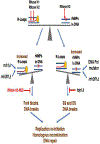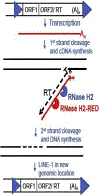RNase H2-RED carpets the path to eukaryotic RNase H2 functions
- PMID: 31761672
- PMCID: PMC6936605
- DOI: 10.1016/j.dnarep.2019.102736
RNase H2-RED carpets the path to eukaryotic RNase H2 functions
Abstract
Eukaryotic RNases H2 have dual functions in initiating the removal of ribonucleoside monophosphates (rNMPs) incorporated by DNA polymerases during DNA synthesis and in cleaving the RNA moiety of RNA/DNA hybrids formed during transcription and retrotransposition. The other major cellular RNase H, RNase H1, shares the hybrid processing activity, but not all substrates. After RNase H2 incision at the rNMPs in DNA the Ribonucleotide Excision Repair (RER) pathway completes the removal, restoring dsDNA. The development of the RNase H2-RED (Ribonucleotide Excision Defective) mutant enzyme, which can process RNA/DNA hybrids but is unable to cleave rNMPs embedded in DNA has unlinked the two activities and illuminated the roles of RNase H2 in cellular metabolism. Studies mostly in Saccharomyces cerevisiae, have shown both activities of RNase H2 are necessary to maintain genome integrity and that RNase H1 and H2 have overlapping as well as distinct RNA/DNA hybrid substrates. In mouse RNase H2-RED confirmed that rNMPs in DNA during embryogenesis induce lethality in a p53-dependent DNA damage response. In mammalian cell cultures, RNase H2-RED helped identifying DNA lesions produced by Top1 cleavage at rNMPs and led to determine that RNase H2 participates in the retrotransposition of LINE-1 elements. In this review, we summarize the studies and conclusions reached by utilization of RNase H2-RED enzyme in different model systems.
Copyright © 2019 Elsevier B.V. All rights reserved.
Conflict of interest statement
Conflict of Interest: The authors declare that there are no conflicts of interest
Figures




Similar articles
-
RNases H1 and H2: guardians of the stability of the nuclear genome when supply of dNTPs is limiting for DNA synthesis.Curr Genet. 2020 Dec;66(6):1073-1084. doi: 10.1007/s00294-020-01086-8. Epub 2020 Sep 4. Curr Genet. 2020. PMID: 32886170 Free PMC article. Review.
-
Two RNase H2 Mutants with Differential rNMP Processing Activity Reveal a Threshold of Ribonucleotide Tolerance for Embryonic Development.Cell Rep. 2018 Oct 30;25(5):1135-1145.e5. doi: 10.1016/j.celrep.2018.10.019. Cell Rep. 2018. PMID: 30380406 Free PMC article.
-
High density of unrepaired genomic ribonucleotides leads to Topoisomerase 1-mediated severe growth defects in absence of ribonucleotide reductase.Nucleic Acids Res. 2020 May 7;48(8):4274-4297. doi: 10.1093/nar/gkaa103. Nucleic Acids Res. 2020. PMID: 32187369 Free PMC article.
-
Abasic and oxidized ribonucleotides embedded in DNA are processed by human APE1 and not by RNase H2.Nucleic Acids Res. 2017 Nov 2;45(19):11193-11212. doi: 10.1093/nar/gkx723. Nucleic Acids Res. 2017. PMID: 28977421 Free PMC article.
-
Structural Studies of RNases H2 as an Example of Crystal Structure Determination of Protein-Nucleic Acid Complexes.Methods Enzymol. 2017;592:123-143. doi: 10.1016/bs.mie.2017.03.009. Epub 2017 May 8. Methods Enzymol. 2017. PMID: 28668118 Review.
Cited by
-
Impact of 1,N6-ethenoadenosine, a damaged ribonucleotide in DNA, on translesion synthesis and repair.J Biol Chem. 2020 May 1;295(18):6092-6107. doi: 10.1074/jbc.RA120.012829. Epub 2020 Mar 25. J Biol Chem. 2020. PMID: 32213600 Free PMC article.
-
Genetic requirements for repair of lesions caused by single genomic ribonucleotides in S phase.Nat Commun. 2023 Mar 3;14(1):1227. doi: 10.1038/s41467-023-36866-6. Nat Commun. 2023. PMID: 36869098 Free PMC article.
-
Genetic and epigenetic factors shape phenotypes and outcomes in systemic lupus erythematosus - focus on juvenile-onset systemic lupus erythematosus.Curr Opin Rheumatol. 2025 Mar 1;37(2):149-163. doi: 10.1097/BOR.0000000000001072. Epub 2024 Dec 11. Curr Opin Rheumatol. 2025. PMID: 39660463 Free PMC article. Review.
-
Ribonucleotide incorporation into DNA during DNA replication and its consequences.Crit Rev Biochem Mol Biol. 2021 Feb;56(1):109-124. doi: 10.1080/10409238.2020.1869175. Epub 2021 Jan 18. Crit Rev Biochem Mol Biol. 2021. PMID: 33461360 Free PMC article. Review.
-
Endogenous DNA 3' Blocks Are Vulnerabilities for BRCA1 and BRCA2 Deficiency and Are Reversed by the APE2 Nuclease.Mol Cell. 2020 Jun 18;78(6):1152-1165.e8. doi: 10.1016/j.molcel.2020.05.021. Epub 2020 Jun 8. Mol Cell. 2020. PMID: 32516598 Free PMC article.
References
Publication types
MeSH terms
Substances
Grants and funding
LinkOut - more resources
Full Text Sources
Molecular Biology Databases
Research Materials
Miscellaneous

